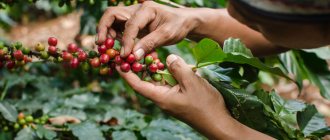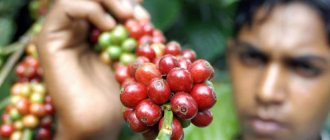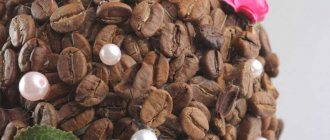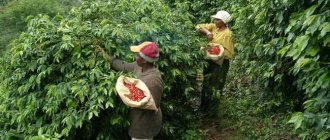07.05.2018
Honey, dry, washed... you've probably wondered, “What do these words mean when describing coffee?” or “Which coffee treatment will suit my tastes best?” Let's figure it out. Coffee processing affects the coffee's flavor profile and balance. There are three main methods of processing grains: washed, natural (dry) and honey (from the English honey - honey). There are alternatives, but they are rarely found in production and are usually a local processing method, such as Wet Hull, also called Giling Basah. We will also tell you about this method.
Washed coffee processing
Washed coffee processing is used mainly in Latin America and some areas of East Africa. It requires cleansing from the top protective layer of the berry and from the adhesive substance covering the skin of the grains themselves, using friction, fermentation and water. After picking, the berries are taken to a water mill. Next, the grains are pulled out of the berry itself using special equipment. At this stage, the grains are covered with a sticky liquid, which includes sugar and alcohols. This sticky substance affects the sweetness, sourness and aroma of coffee. Once the grains are separated from the berries, they are placed in fermentation tanks for 12 to 24 hours depending on temperature, although producers have begun experimenting with fermentation times to create new flavor profiles. For example, prolonged fermentation means that the beans absorb more sugars and therefore taste sweeter. After fermentation, the sticky substance breaks down and leaves the beans covered only with coffee “parchment”—the skin. Now the grains are ready for washing. This is done in tanks with clean water. At the exit, the grains harden, which means they are ready for drying. The grains are dried for approximately 10-22 days, during which they are turned regularly. This slow drying is considered optimal for obtaining balanced coffee. Washed processing focuses only on the grain, it reveals what is inside it, but not what is outside. Many believe that this method reveals the true character of the variety like no other, which is why most specialty coffees are processed this way.
What is the difference between Yellow, Red and Black Honey?
So, after getting acquainted with the term “hani”, it’s time to study the different types of this process. This description is rarely found on coffee packaging, but producers and exporters use terms such as white honey, yellow honey, gold, red and black honey.
White and yellow honey – when processing coffee cherries after mechanical cleaning, a small amount of gluten remains on the bean.
Golden, red and black honey - in this case, on the contrary, when processing the coffee berry after mechanical cleaning, a larger amount of gluten remains. As a result, the coffee is fuller-bodied.
Is it possible to formulate these processes in even more detail? In fact yes. But this processing method can be affected by factors such as humidity, temperature, sugar oxidation - all of which do not allow for an accurate description. Roughly speaking, the Hani method can be divided as follows:
White and Yellow Honey
Processed white honey coffee is mechanically washed and as a result, a minimal amount of gluten remains on the beans. Yellow honey – semi-washed with a slightly larger layer of gluten.
However, these terms will differ from farm to farm. And no matter what the processing process is called, it is always better to find out exactly how the coffee was processed before buying or selling coffee. To avoid misunderstandings on all sides!
White honey, complex and unique. ©Caffe Pecora
Gold, Red and Black Honey
What distinguishes these three processes is the amount of light and the time for which the grain is left to dry. With high humidity and a slow processing process, black honey . A little less moisture and we get red honey , even less moisture - golden .
Golden Hani is dried in warm, sunny weather with low humidity. For red honey , the process takes place in the shade to slow down the drying process. This allows you to increase the amount of moisture that has such a strong effect on the grain. And to get black honey , it takes even more time, and the drying process takes place with even less light.
Black honey processed coffee has a rich taste, aroma and is more expensive. ©Gold Mountain Coffee Growers
Dry coffee processing (natural)
The most ancient method of processing coffee. Traditionally used for large-scale coffee production due to low cost, such as in Brazil, or due to the limited amount of water in the region, such as Ethiopia. After harvesting, the coffee berries are dried in the sun. In large-scale production, they are usually placed on concrete or brick surfaces, sometimes on the ground to absorb moisture. For this reason, when dry processed, the coffee beans will have more defects - even an earthy smell due to drying on bare ground. Washed coffee has always been more expensive due to its purity and balance, but more and more producers are giving preference to naturally processed beans because of the scope for flavor experimentation. When carried out correctly, dried on absorbent surfaces and turned regularly, natural processing can produce a unique coffee taste with hints of strawberry, mango and blueberry in the finish. Drying occurs without clearing the top layers, which allows the berry to ferment naturally. The grains absorb all the substances contained in the berry. As a result, the brewed coffee has an unusual flavor profile. After drying, the berries resemble raisins in appearance, and the grains are cleared of their outer layers. Brewed coffee will have a pronounced sweet taste.
What happens after coffee beans are processed?
After processing, the coffee beans are still covered with a parchment layer (unless they are processed using the Giling basah method).
Now the moisture content of the grains is low enough for storage so that they do not undergo putrefactive decomposition. Typically the grains are kept in storage (= dry storage) for 1-2 months before export. Immediately before export, the grain is cleared of the parchment layer. The treatment is done mechanically using a dry exfoliator (as opposed to a wet exfoliator/depulper in a washed treatment). After shelling, the grains are sorted and graded by size using machines that check the size and color of the grains. The grains are also sorted on the surface of a large sieve with holes of different sizes or manually. After grading and sorting, the grains are packed in jute bags of 60 or 69 kg, depending on the country of origin. Jute bags are loaded into ship containers, which protect the beans during their long journey to the roaster.
sorted grains ready for export Post Views: 2,504
Honey (semi-washed coffee processing)
When semi-washed, the coffee tastes literally honey-like, as if brown sugar had been added to a cup of coffee, although the name comes from the similarity in appearance and consistency of the beans to the consistency of honey. This method sometimes confuses roasters and consumers because it varies depending on the country of origin: it is usually somewhere between a washed process and a dry process. Hani processing is a hybrid process that is open to “author’s” interpretations. In Brazil, for example, research was conducted to find a way to process coffee that would use less water than washed coffee, but would be more resistant to defects than natural coffee. This is how they began to use khani, in which the top peel and partly the sticky substance are removed, after which the grains are sent for drying. The coffee turns out sweetish, as with natural processing, while adding a slight sourness to the taste. Central America and El Salvador pay more attention to experiments, so semi-washed processing uses a scientific approach and removes a strictly defined and verified amount of sticky liquid. This precise process of honey processing creates distinctive coffee flavors. The drying process becomes especially important here because the risk of mold and insect damage becomes greater.
How do manufacturers decide which process to use?
Most coffee producers want to produce the most profitable and therefore the best tasting coffee possible. However, their capabilities and desires are limited by environmental conditions. Coffee, like most food products, has a very close connection with the environment and climate.
Manufacturers often look at the amount of moisture deposited before choosing a treatment method. If the season was rainy, then it is difficult to get a good natural process because the coffee cherry will start to spoil. If there has been no rain, then the conditions for honey processing or the natural drying method are excellent because the sugar is not washed out.
Often coffee farmers use refractometers on their farm to measure sugar content. This helps them decide if the sugar content is enough for natural or honey coffee. However, they also strive for high sugar content in their washed coffees as this results in a sweeter cup.
dry coffee processing
Wet Hall (Giling Basah)
This processing method is commonly associated with Indonesia, where Giling Basah translates to "wet grinding". During this treatment, the coated coffee bean is removed from the berry and then partially dried in the sun until the water content is reduced to 30-35%. The casing is then removed and drying continues until the water content is low enough to avoid mold. After this, the grains become greenish or blue in color, which distinguishes Indonesian processing from all others. This process is not without its challenges: by removing the protective layer at an early stage, the grains may be exposed to insects during the most critical stages of processing. Beans processed in Indonesia are usually associated with woody, earthy or pungent flavors, which are considered to be the result of this unique processing process. Some will admire such shades, while others will consider them a drawback.
Experimentation and innovation: the future of coffee processing
Traditionally, coffee countries have favored one processing method. For example, in Rwanda and much of Central America, washed processing has historically taken hold, while in Brazil, honey or natural processing has been more common. This is now gradually changing, thanks to the increasing demand for specialty coffee. More and more producers are trying other processing methods when natural and climatic factors allow. For example, in Nicaragua, Guatemala and Rwanda, many use honey and natural processing. There's more to it than simply choosing a processing method: some are trying fermentations without oxygen, while others are looking for catalysts to speed up fermentation. Also, many are experimenting for environmental reasons and trying to process grains with minimal use of water. The coffee processing process is not an often covered topic, but it is a fundamental part of the coffee industry. Next time you choose Vietnam's Lam Dong washed process or Brazil's Santos dry process, you'll know what to expect.
Try our coffee
Mix of grains
Espresso coffee
Blend of 100% Arabica beans. The aroma reveals notes of roasted peanuts and hazelnuts, while the taste is dominated by dark chocolate and walnuts. Soft aftertaste of cocoa and burnt sugar.
Peru
Coffee "Chanchamayo"
Rich and strong coffee with notes of bread in the aroma.
Brazil
Coffee "Santos"
The aroma is dominated by spices and cocoa. The soft nutty-chocolate taste is offset by a slight sourness at the end.











